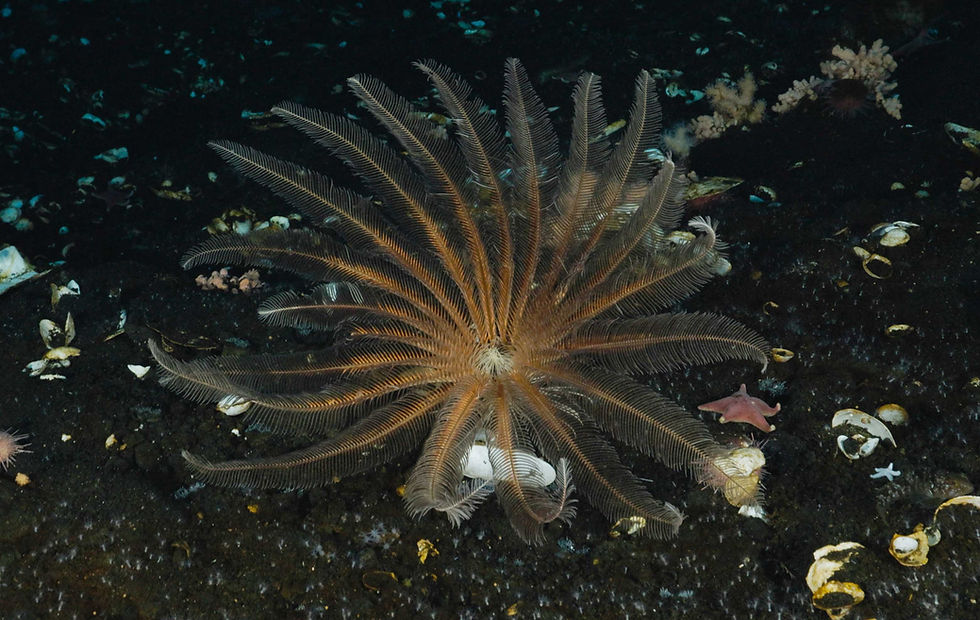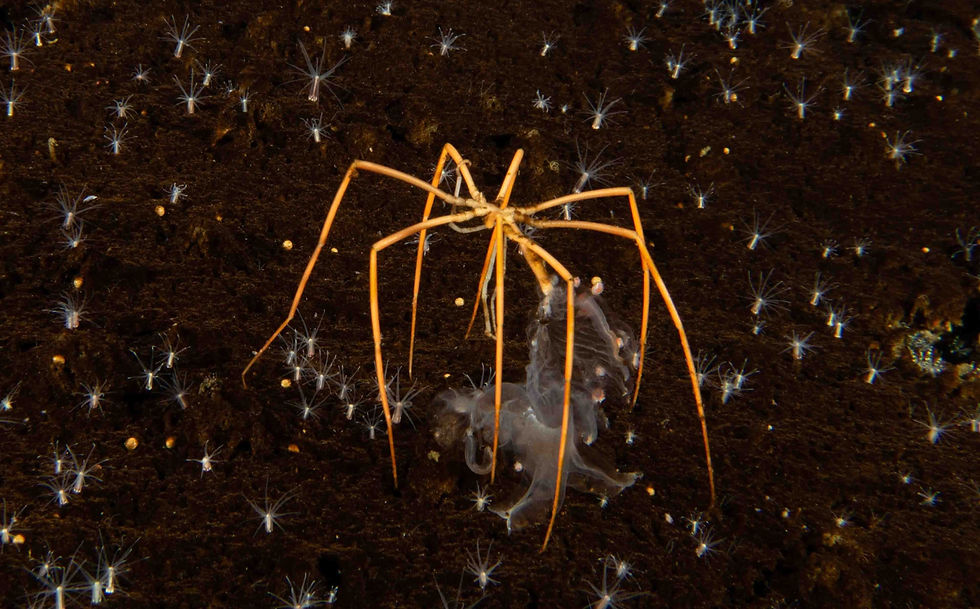Antarctica: Season 2
- Rowan McLachlan
- Oct 21, 2023
- 6 min read
348 days after leaving Antarctica, I am back on the ice. This is my second visit to the frozen continent, and I am unbelievably excited to be here!

Our expedition was initially set to begin in mid-August (i.e., at Winfly), but due to various funding and budget issues, the start of our season was unfortunately canceled. It was a real blow for the project as we aimed to collect seafloor sediment samples right at the end of the Antarctic winter when it was still 24 hours of darkness. This was really important as one of the main goals of our science is to study chemosynthesis: the production of organic compounds by microbes and other organisms using energy derived from inorganic chemicals in the absence of sunlight (and thus photosynthesis). We arrived last week, and now the sun shines 24 hours a day. Alas, we will make the best of our time! We are fortunate to be in Antarctica conducting science when several other research projects were canceled entirely this year. Therefore we will do our best to achieve our scientific objectives despite the shorter duration of our trip. Science is problem solving after all!
As I get caught up with my blogs, let me start by telling you about the first leg of our journey here.
We departed Corvallis, Oregon at 5:30 a.m. on Thursday, October 5th. After a two-hour drive to Portland airport, we then checked in for our flights. As was the case last year, the travel agents who organized our travel sent us first to San Fransisco, then onto Los Angeles, before heading across the Pacific Ocean to New Zealand (first Auckland, then Christchurch). I have superimposed our flight path onto a map below.

This map projection of the globe was drawn in 1890 and at that time, the Antarctic continent had not yet been defined. Only 133 years later, we now have satellite imagery of the entire landmass, and getting there is as "easy" as a few commercial, and one military flight. Alas, how times have changed!

Our journey to New Zealand was long (~36 hours) and involved transit through five airports to get to the Antarctic gateway city of Christchurch.

Our team: Jacob Wynne, Sleepy Me, Andrew Thurber, and Michael Rodriguez (photographer)
The flight from Auckland to Christchurch is one of my favourites though as we fly over the Southern Alps and are gifted with phenomenal views.
As we come in to land at Christchurch, we fly over the stunning Waimakariri River.


We arrived in Christchurch early in the morning on Friday, Oct 6th. We took a shuttle bus to our (first) hotel: The Carnmore. I was really jet-lagged and didn't manage to stay awake much past 5 p.m.!
On Saturday, Oct 7th, we headed to the Clothing Distribution Center (CDC) for COVID PCR tests and to be issued our extreme weather gear. To learn more about all of the warm clothing we need in order to survive in Antarctica, read this blog post I wrote about our visit to the CDC last year!

On Sunday, Oct 8th, we visited the Tūranga City Library to see an exhibit about women working at the North and South Poles. The project was called Polar Women and "draws from a growing network of female polar researchers who, through sharing their stories and experiences, hope to inspire the careers of other women. These extraordinary scientists are shaping the way we understand the polar regions, and ultimately the effect of climate change on us all. Working against the odds in extreme environments, their findings highlight how essential the natural world is to our survival, and how crucial polar research is in safeguarding our future."
I photographed the 15 poster exhibits and have shared them in the gallery below. Scroll through and check out all of the ground-breaking polar research being conducted by phenomenal women scientists from around the world!
After visiting the library, we headed over to the Canterbury pop-up museum. Unfortunately, the main Christchurch museum is currently undergoing renovations, so only a few items were on display at this temporary establishment. However, they did have a few artifacts relating to early Antarctic exploration. My favorite was the wooden goggles to prevent snow blindness!
To finish our Sunday of adventure, we headed over the Avon River to visit the statue of Robert Falcon Scott. Scott was a British Royal Navy officer and explorer who led two expeditions to the Antarctic regions: the Discovery expedition of 1901–04 and the Terra Nova expedition of 1910–13. The inscription on the statue (which was carved by his widow, Kathleen Scott, in 1916) is from one of Scott's last diary entries before he died attempting to reach the South Pole, and reads:
"I do not regret this journey, which shows that Englishmen can endure hardships, help one another, and meet death with as great fortitude as ever in the past."

When we arrived at the statue, however, we were surprised to see there was a ceremony taking place. We only caught the tail end, but when the ceremony was over we learned that it was hosted by the New Zealand Antarctic Society. Every year, the Antarctic Society meets at the statue for their wreath-laying ceremony for the recognition and commemoration of Antarctic contributions past and present.

The wreath-laying ceremony commenced in the 1930’s when Admiral Byrd celebrated Scott. Since then the NZ Antarctic Society, joined by Antarctica NZ and the Antarctic Office, has gathered the citizens of their gateway city and international visitors, to lay commemorative wreaths and say a few words to celebrate our connections with Antarctica. Four wreaths are laid. These represent the city Otautahi Christchurch, the New Zealand Antarctic Society, the explorers and science currently coordinated by Antarctica NZ, and the international community collaboration.

We were scheduled to fly to Antarctica on Monday, Oct 9th, but that evening we received word that our flight was postponed a day due to bad weather in Antarctica. So on Monday, we decided to go on a nice 10-mile walk from downtown Christchurch to the coast to New Brighton Pier. Such a beautiful spring day!

Tuesday, Oct 10th: another flight delay due to bad weather in Antarctica. Many factors are considered when making the decision about whether it is safe to fly to, and land in Antarctica. The main components are visibility, wind speed, and cross-winds. Fingers crossed we fly soon!

Wednesday, Oct 11th: time to move hotels. Our new accommodations: The Breakfree.
Thursday, Oct 12th: flight delayed 24 hours due to bad weather. To pass the time, we visited the CatNap Cat cafe. Nothing like adorable cats to cheer you up when you are waiting to fly to Antarctica!

Friday, Oct 13th: everyone packed and ready to depart at 5:30 a.m. However, we then received news of a 4-hour delay, followed by a 2-hour delay, followed by confirmation that the flight was canceled. Again, due to bad weather.
Saturday, Oct 14th: Things looking promising for today! At 5:30 a.m., we were picked up by a shuttle bus and driven out the the airport.

Left to right: Amy Moran, Me, Jacob Wynne, Andrew Thurber, and Michael Rodriguez
At the CDC, it was time to collect and don some of our extreme weather gear (ECW).

Next, it was time to check in for our flight, weigh our bags, and weigh ourselves in our ECW! The US Air Force (with whom we are traveling today) weighs every item that is loaded onto the plane. By doing so, they can calculate how much room there is for additional supplies, such as fresh vegetables and other cargo that is waiting to be transported down onto the ice.


A couple of hours later, it was time to board our flight. A shuttle bus drove us to the airstrip.

As we approached the C17 plane, however, things weren't looking so good. Two mechanics were working on the wing...

30 minutes later, we finally got off the bus and started to board! Apparently, the wing issue was fixed!

We got settled into our seats and listened to the flight safety brief.

Left to right: Me, Rob Robbins, and Amy Moran
Everyone was very excited! However, then the waiting game began. We waited and waited and waited...

Almost two hours went by....then we got the bad news. The flight was canceled. This time due to bad weather in Christchurch! When I looked at the weather report, I was actually very glad that we didn't fly through this storm:
Disappointed, we disembarked from the C17. At least Jacob is still smiling!

This event is known as a "boomerang". Boomerangs can happen even if the flight takes off from New Zealand. The flight to Antarctica can take between 5-8 hours, and after we take off, there is always a chance that the weather can turn bad in Antarctica (conditions can deteriorate very rapidly there) to the point that we would not be able to land the plane. In that event, they turn the plane around and head back to New Zealand: hence the phrase "boomerang".
We do not receive all of our luggage, and instead, only our carry-on bag and boomerang bag are returned to us. We are moved to our third hotel: The Sudima. The day is spent disappointed yet hopeful that maybe, just maybe, tomorrow will be the day!
...And it was! The next blog coming soon!























































Comments